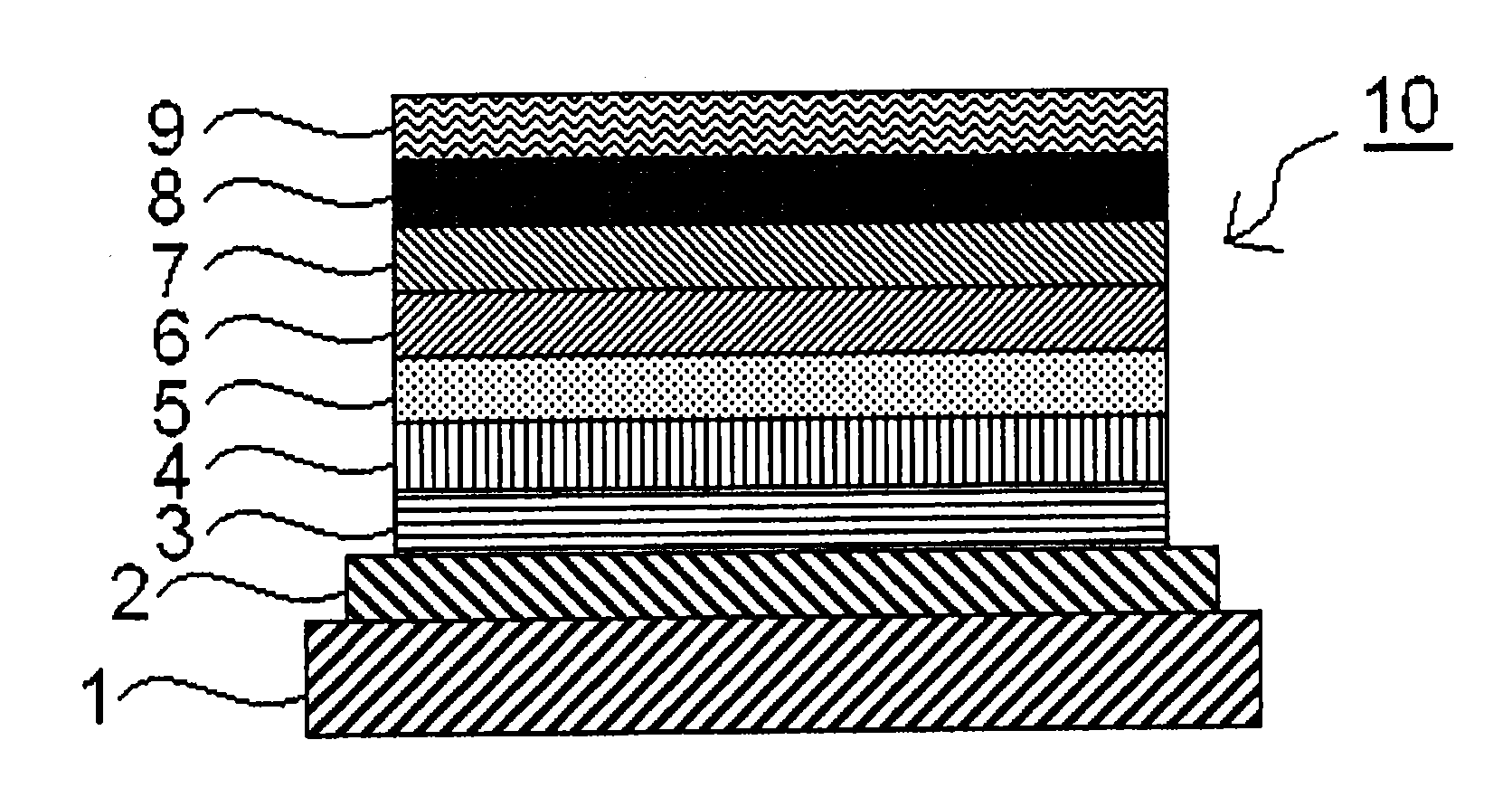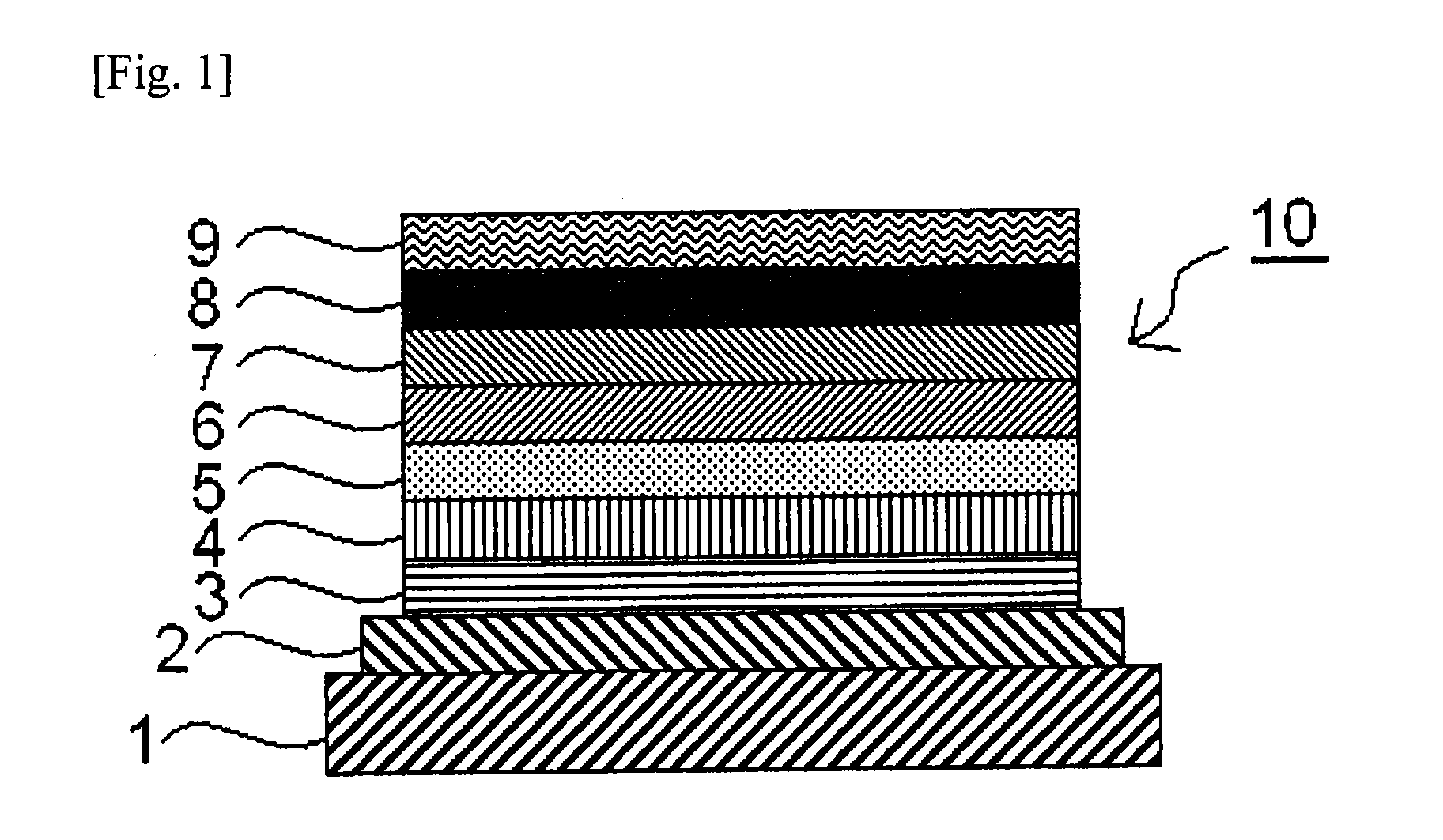Polymer and organic electroluminescent element
a technology of organic electroluminescent elements and polymers, which is applied in the direction of electrical equipment, semiconductor devices, solid-state devices, etc., can solve the problems of poor driving stability, difficult lamination, and production according to wet film formation methods, and achieve excellent driving stability, high hole transporting ability and electrochemical stability. , the effect of high efficiency
- Summary
- Abstract
- Description
- Claims
- Application Information
AI Technical Summary
Benefits of technology
Problems solved by technology
Method used
Image
Examples
example 1
[0409]An organic electroluminescent element was produced according to the following process.
[0410]A glass substrate 1 having, as deposited by sputtering thereon, an indium tin oxide (ITO) transparent conductive film, was patterned to have a stripe anode 2 having a stripe width of 2 mm, according to ordinary photolithography combined with hydrochloric acid etching. The thus-patterned ITO substrate was ultrasonically washed with an aqueous surfactant solution, washed with ultrapure water, ultrasonically washed with ultrapure water, and washed with ultrapure water in that order, then dried, and washed with UV ozone.
[0411]Next, a composition for forming hole injection layer was prepared, comprising an arylamine polymer represented by the following structural formula (P-1), 4-isopropyl-4′-methyldiphenyliodonium tetrakis(pentafluorophenyl)borate represented by the following structural formula (A-1) and ethyl benzoate. The composition for forming hole injection layer was applied onto the a...
example 2
[0422]A glass substrate 1 having, as deposited by sputtering thereon, an indium tin oxide (ITO) transparent conductive film, an anode 2 was patterned to have a stripe anode 2 having a stripe width of 2 mm, according to ordinary photolithography combined with hydrochloric acid etching. The thus-patterned ITO substrate was ultrasonically washed with an aqueous surfactant solution, washed with ultrapure water, ultrasonically washed with ultrapure water, and washed with ultrapure water in that order, then dried, and washed with UV ozone.
[0423]Next, a composition for forming hole injection layer was prepared, comprising an arylamine polymer represented by the structural formula (comparative polymer 2) and the structural formula (comparative polymer 3) shown below, 4-isopropyl-4′-methyldiphenyliodonium tetrakis(pentafluorophenyl)borate represented by the above-mentioned structural formula (A-1) and ethyl benzoate. The composition for forming hole injection layer was applied onto the anode...
example 3
[0440]An organic electroluminescent element was produced in the same manner as in Example 2, except that the composition for forming hole injection and the composition for forming hole transport layer were changed to the following, and tested for the operation life also in the same manner, and the result is shown in Table 8.
[0441]
Solventethyl benzoateComposition concentrationcomparative polymer 3: 2.625% by weighttarget polymer 3: 0.875% by weightA-1: 0.7% by weight
[0442]
SolventcyclohexylbenzeneComposition concentrationcomparative polymer 1: 1.0% by weight
PUM
| Property | Measurement | Unit |
|---|---|---|
| carbon number | aaaaa | aaaaa |
| carbon number | aaaaa | aaaaa |
| carbon number | aaaaa | aaaaa |
Abstract
Description
Claims
Application Information
 Login to View More
Login to View More - R&D
- Intellectual Property
- Life Sciences
- Materials
- Tech Scout
- Unparalleled Data Quality
- Higher Quality Content
- 60% Fewer Hallucinations
Browse by: Latest US Patents, China's latest patents, Technical Efficacy Thesaurus, Application Domain, Technology Topic, Popular Technical Reports.
© 2025 PatSnap. All rights reserved.Legal|Privacy policy|Modern Slavery Act Transparency Statement|Sitemap|About US| Contact US: help@patsnap.com



